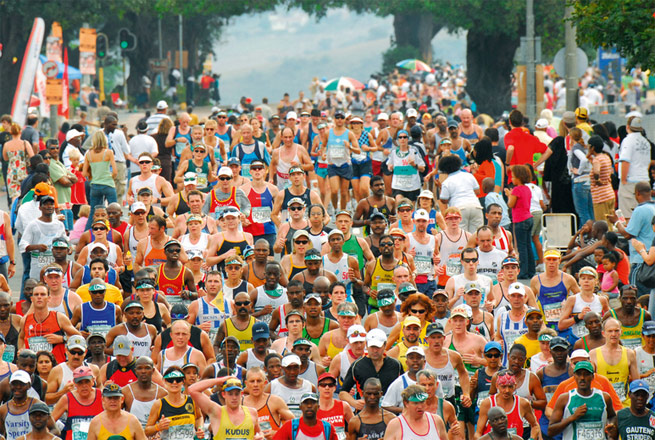 The other day, I was stunned to learn from a committed runner that she got sore from… walking. And when I say “committed”, I mean someone who gets up at four (in the morning!) to run around the neighbourhood and participates in Comrades Marathon and similar super-human events.
The other day, I was stunned to learn from a committed runner that she got sore from… walking. And when I say “committed”, I mean someone who gets up at four (in the morning!) to run around the neighbourhood and participates in Comrades Marathon and similar super-human events.
What, she’s fine with running, but complains about walking?!
So, I did some research, and – lo and behold! – turns out that body primed for running may indeed suffer when forced to walk. (Important note: we’re talking here about serious walking over a long distance, not about a leisurely amble around a park.)
Whether you walk or run, you work your whole body. However, some parts of the body work harder when running (ankles, knees), and some work harder when walking (hips, lower back). It follows that if you trained as a runner and suddenly had to switch to walking, you may need ice packs for your lower back.
With that mystery out of the way, let’s concentrate on the crucial question: what is better for your overall health, running or walking?
The short answer is: anything that gets you off the couch is good for you.
And here is the longer answer: it depends on what you are hoping to achieve. If you are looking to control your weight, running wins, because runners burn more calories and because they eat less. However, when it comes to building endurance, strengthening the bones and improving overall health, the benefits from the two activates are more or less on a par. Both walkers and runners are less likely to have high blood pressure, unhealthy cholesterol profiles, diabetes and heart disease than their sedentary peers.
 So, if you can’t decide between the two, combine walking and running in what is known as run/walk. Basically, you walk for about five minutes, then run for a minute or two, or longer if your fitness level allows. The idea is to get back to the walking part before you start gasping and convulsing. That way, your muscles will recover for another, and another, and another… bout of running. If you run until you’re very tired, you’ll end up dragging your feet instead of walking, and your body will refuse to burst into a run again.
So, if you can’t decide between the two, combine walking and running in what is known as run/walk. Basically, you walk for about five minutes, then run for a minute or two, or longer if your fitness level allows. The idea is to get back to the walking part before you start gasping and convulsing. That way, your muscles will recover for another, and another, and another… bout of running. If you run until you’re very tired, you’ll end up dragging your feet instead of walking, and your body will refuse to burst into a run again.
You need not abandon the run/walk method after your stamina improves. Many experienced long-distance runners use run/walk in training because this technique reduces muscle fatigue and the risk of injury.
Whether running, walking or run/walking, it is important to do it properly. Here are some tips from experts:
- Keep your abs tight and actively engaged for stability and good posture.
- Maintain tall body alignment: head high, chin parallel to the ground, back straight, shoulders relaxed and away from the ears.
- Flex (pull up) your toes as you step and keep them pointed in the direction you want to go.
- Use a comfortable stride length with soft, unlocked knees.
- Bend your elbows at 90 degrees and swing your arms from shoulders.
- Make sure your breathing is relaxed and deep. Your heart should be pumping hard, but you should not gasp for oxygen.
- Always warm up before, cool down afterwards, and keep your body hydrated.
- Do what feels natural for your body. Don’t try to force it into this or that angle or stride just because you think it makes you look like Usian Bolt.
- Equipment-wise, good footwear is a must. (Since every person’s foot is different, you need to find out what suits you best: minimalist flat running shoes, or cushioned supportive ones, or something in-between.) While not strictly speaking necessary, it’s good to have a heart monitor (for gauging your exertion levels) and an MP3 player (to help you keep the pace).
What if it hurts, you may ask? Well, a certain level of pain is a by-product of every exercise (especially running). Aching muscles are normal, even welcome (it means you’ve been working them). If soreness persist for longer than a day or two, treat yourself to a massage and keep on exercising, though perhaps at a gentler pace.
As for more serious injuries that can occur, I have a three-pronged approach:
- Prevent injuries by maintaining a good form and a reasonable pace;
- Heel them by allowing body some rest and seeking medical attention if necessary;
- Take up exercising again as soon as possible. (Nothing is worse than sitting!)
Now that you know everything about it, get running, walking or run/walking! No other form of exercise is so accessible and affordable. Enjoy, and see you at the next Comrades! (Perhaps.)










